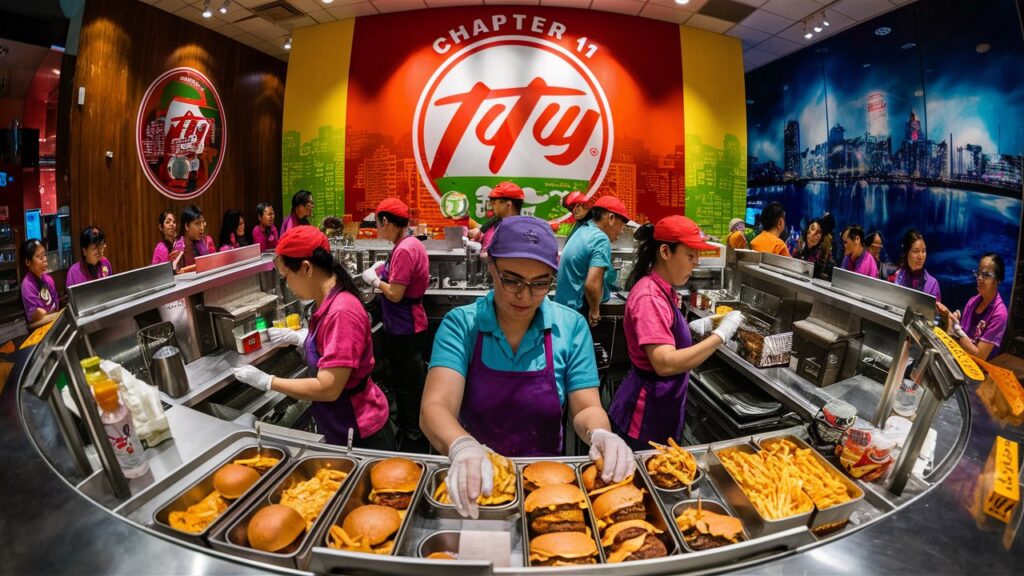
Chapter 11 bankruptcy can be a critical turning point for a fast-food operator struggling to stay financially afloat. This legal process, overseen by the US Bankruptcy Court, offers a pathway for companies to restructure their debts and operations, giving them a chance to return to profitability.
Understanding Chapter 11 Bankruptcy
Chapter 11 bankruptcy is a legal shield for companies facing severe financial difficulties. It offers protection from creditors, preventing them from seizing assets or demanding immediate repayment. This legal framework allows companies to reorganize under the court’s supervision, providing a structured environment to address financial woes.
Why Fast Food Operators Turn to Chapter 11
Financial strain is a primary driver for fast-food operators filing for Chapter 11. Factors such as declining sales, rising operational costs, or overwhelming debt can push a company toward this legal recourse. Chapter 11 offers a chance for these operators to negotiate with creditors, reducing rent payments or renegotiating loan terms, which is crucial for survival.
The Restructuring Opportunity
Chapter 11 is not just about survival; it’s about restructuring and finding a viable path forward. For fast-food operators, this could mean negotiating with landlords for lower rent, adjusting supply chain agreements, or renegotiating loan terms to better manage cash flow. The goal is to emerge from Chapter 11 with a more sustainable financial structure and a clear path to profitability.
Possible Outcomes for Fast Food Operators in Chapter 11
The outcomes of a Chapter 11 filing can vary widely. In a successful reorganization, the operator devises a plan to repay creditors over time while becoming profitable again. This might involve closing underperforming locations, renegotiating contracts, or revamping the menu to attract more customers.
Also Read: Wallpaper:hq2hr3icmae= cats: Discover the Best Cat Wallpapers
Sale of Assets as a Strategy
Sometimes, fast-food operators may sell some or all of their restaurants to pay off debt. This can lead to the closure or rebranding of specific locations, allowing the remaining outlets to operate more efficiently and with less financial burden.
The Worst-Case Scenario: Liquidation
If reorganization or asset sales are not viable, the operator might be forced into liquidation. This involves shutting down operations permanently and selling all assets to repay creditors. While this is the worst-case scenario, it is a possibility that companies must consider.
Recent Examples in the Industry
Several large fast-food franchise operators have turned to Chapter 11 in recent years. Notable examples include some Burger King and Popeyes franchises. These cases highlight the pressures within the fast-food industry and the use of Chapter 11 to address these challenges.

Impact on Employees
Filing for Chapter 11 can have significant implications for employees. Job losses are expected, especially if the company closes underperforming locations. Employees may face uncertainty and disruption as the company navigates the bankruptcy process.
Customer Experience During Chapter 11
Customers are not immune to the effects of a Chapter 11 filing. They might experience disruptions in service or changes at their favorite locations. Menu changes, store closures, and rebranding efforts can alter the dining experience, sometimes leading to customer dissatisfaction.
The Role of Court Supervision
Court supervision in Chapter 11 ensures that the restructuring process is fair and transparent. It helps protect the company’s and its creditors’ interests, providing a balanced approach to resolving financial difficulties.
Negotiating with Creditors
A critical aspect of Chapter 11 is negotiating with creditors. Fast-food operators can use this opportunity to reach more favorable terms, such as extended repayment schedules or reduced interest rates. Successful negotiations can significantly enhance the company’s chances of recovery.
Revamping Business Strategies
Chapter 11 often prompts companies to revamp their business strategies. For fast-food operators, this could involve updating their menus, improving service quality, or enhancing marketing efforts to attract more customers and boost sales.
Focus on Core Operations
During the restructuring process, fast-food operators might focus on their core operations. This could mean streamlining menus, optimizing supply chains, and improving operational efficiency to reduce costs and enhance profitability.
The Path to Profitability
The ultimate goal of Chapter 11 is to return to profitability. For fast-food operators, this involves creating a sustainable business model that can withstand market pressures and continue to grow. Achieving this requires careful planning and execution.
Challenges in the Chapter 11 Process
The Chapter 11 process is fraught with challenges. Companies must navigate complex legal and financial landscapes, often under tight timelines. Effective management and clear communication are essential to overcome these hurdles.
The Importance of Legal Counsel
Having experienced legal counsel is crucial for fast-food operators undergoing Chapter 11. Lawyers can help navigate the legal intricacies, negotiate with creditors, and ensure compliance with court requirements, providing vital support.
Learning from Past Cases
Examining past cases of fast-food operators who have filed for Chapter 11 can provide valuable insights. Learning from the successes and failures of others can help companies make informed decisions and avoid common pitfalls.
Also Read: beautiful:by5oj2_qmci= flowers
The Role of Stakeholders
Stakeholders, including employees, customers, suppliers, and creditors, play a significant role in the Chapter 11 process. Their cooperation and support can be pivotal in successfully restructuring and ensuring the company’s viability.

Long-term Implications
The long-term implications of a Chapter 11 filing can vary. Successful restructuring can lead to a stronger, more resilient company, while failure can result in liquidation. Companies must carefully consider their strategies and actions to ensure positive outcomes.
Conclusion
“Fast Food Operator Chapter 11” signifies a challenging yet potentially transformative phase for struggling companies. While the process can be daunting, it offers renewal and growth opportunities. By understanding the intricacies of Chapter 11 and navigating it effectively, fast-food operators can emerge more robust and more competitive in the market.